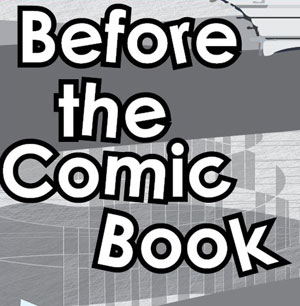June – October 2009
The modern American comic book is an invention of the early 20th century. As with its predecessors the political cartoon and newspaper comic strip, the comic book can provide an intriguing, entertaining, and sometimes critical mirror of society. Through the decades of the last century and into our own, comic books have influenced culture as well as reflected it. Now an ingrained part of our cultural lexicon, the characters, conventions, art, and even language of comic books are everywhere including advertising, politics, and entertainment, in addition to being the subject of a growing field of scholarship. From their humble beginnings as reprints of comic strips, comic books have matured into works of art, literature and cultural significance in their own right.
 Comic strips in the 1890s and early 20th century served to entertain and attract readers to the newspapers in which they appeared. The name “comic strip” derives from their largely humorous content (also the reason they are referred to as “funnies”) and arrangement in a sequence of panels. Early comics of note include Richard Outcault’s Hogan’s Alley, featuring The Yellow Kid (first printed in color in 1895), Rudolf Dirk’s The Katzenjammer Kids (1897), Winsor McCay’s Little Nemo in Slumberland (1905), and Bud Fisher’s Mutt and Jeff (1907).
Comic strips in the 1890s and early 20th century served to entertain and attract readers to the newspapers in which they appeared. The name “comic strip” derives from their largely humorous content (also the reason they are referred to as “funnies”) and arrangement in a sequence of panels. Early comics of note include Richard Outcault’s Hogan’s Alley, featuring The Yellow Kid (first printed in color in 1895), Rudolf Dirk’s The Katzenjammer Kids (1897), Winsor McCay’s Little Nemo in Slumberland (1905), and Bud Fisher’s Mutt and Jeff (1907).
Comic strips quickly broaden their content: the quotidian stories of Frank King’s Gasoline Alley begin to unfold in real time in 1918. Other popular strips include George Herriman’s poetic, absurdist Krazy Kat (1913), Harold Gray’s social melodrama Little Orphan Annie (1924), adventure tales like Philip Nowlan and Dick Calkins’ Buck Rogers in the 25th Century A.D. (1929), and Chester Gould’s crime-fighting cop Dick Tracy (1931).

The early 1930s are still dominated by newspaper comic strips. While many of these are collected and reprinted in book form, they are not yet in the eventual format of the “comic book” (actually a periodical magazine): reprints are often tabloid (half-newspaper) size, with cardboard covers, or in the case of popular “Big Little Books,” single panels facing pages of text.
A precursor to the comic book, Funnies on Parade, is produced in 1933 by the Eastern Color Printing Company. Max C. Gaines and colleagues reprint color Sunday comic strips as a promotional 8 page magazine; Proctor & Gamble mails them to customers who send in coupons from their soap products. A second comic book, Famous Funnies: A Carnival of Comics, expanded to 68 pages, follows in 1934 and Gaines stamps a 10¢ price on the cover and drops them at several newsstands. The issue sells out, demonstrating a new market for the new format.
National Allied Publications, soon better known as DC Comics, publishes Action Comics #1 featuring Superman in June, 1938. The creation of writer Jerry Siegel and artist Joe Shuster, the success of “The Man of Steel” inaugurates the Golden Age of comics and establishes the conventions of the new superhero genre.
Detective Comics #27 is published by DC Comics in May 1939 and contains the first appearance of the costumed crime fighter Batman created by artist Bob Kane and writer Bill Finger. Together, Superman and Batman will define the light and dark shades of the American superhero for decades to come.

1940 sees an explosion of comic book superheroes: The Flash, Hawkman, The Spectre, and Hourman all debut in DC comic books, and Batman is joined by his teenage sidekick Robin. Timely Comics (later renamed Marvel) puts the Human Torch (often battling his nemesis The Sub-Mariner) in a solo title and in Whiz Comics from Fawcett Comics the extremely popular Captain Marvel begins with a “SHAZAM!”
In 1941 Joe Simon and Jack Kirby create Captain America for Marvel Comics: the quintessential patriotic superhero, “Cap” is eager to enter World War II before Pearl Harbor, fighting his arch-nemesis and Nazi spy The Red Skull. Soon Captain America is teamed up with his sidekick Bucky, the Human Torch and his pal Toro, and even The Sub-Mariner as the “All-Winners Squad” to continue the good fight.
Wonder Woman first appears in All-Star Comics in November 1941. The Amazon warrior princess is the creation of writer Charles Moulton and artist Harry G. Peter. Moulton was actually psychologist Dr. William Moulton Marston, a strong proponent of female superiority and creator of a blood pressure test crucial to the development of the polygraph, or “lie detector” (a device whose function resembles Wonder Woman’s “lasso of truth”).
Superheroes are not the sole territory of comic books in the 1940s. Crime, Horror, Western, and Romance comics are also very popular. Will Eisner’s crime-fighter The Spirit first appears as a newspaper insert in June 1940 and perennial teenager Archie Andrews makes his first appearance in Pep Comics in 1941 along with Betty, Veronica, Jughead, and Reggie. Funny animal comics also introduce characters like Walt Kelly’s Pogo in Animal Comics and the uncredited Carl Barks’ Uncle Scrooge McDuck, in Dell’s Four Color Series.

Charles Schulz’s comic strip Peanuts is first published on October 2nd, 1950 in eight newspapers. A revision and expansion of a strip Schulz first started in 1947 called Li’l Folks, Peanuts will continue to be published for the next fifty years and provide some of the most memorable characters in American popular culture, especially everyman Charlie Brown and his imaginative beagle Snoopy.
William M. Gaines inherits EC Comics from his father in 1947. EC becomes especially notorious for their crime and horror comics like Tales from the Crypt, The Vault of Horror, and Crime SuspenStories. Due to growing concerns over their impact on children and threats of official censorship, the industry establishes the Comics Code Authority, with rules that will not let the EC titles survive. However, Gaines creates a humor title in 1952 that does survive and is still published today, Mad Magazine, a major influence on the next generation of cartoonists.
In 1954 psychiatrist Dr. Fredric Wertham publishes Seduction of the Innocent: The Influence of Comic Books on Today’s Youth; in the same year the Senate Subcommittee on Juvenile Delinquency investigates the role comics play in juvenile crime. Fears generated by such high-profile events lead to the creation of the comic’s industry self-regulatory body, the Comics Code Authority.
In the wake of the Senate hearings and the establishment of the Comics Code Authority, titles without a seal of approval are almost impossible to sell. The code’s guidelines especially affect crime and horror comics whose graphic images and content are exactly what the code bans, even going so far as to restrict the use of the word “crime” in comics titles and banning the terms “horror” and “terror” altogether. The code also insists that “in every instance good shall triumph over evil and the criminal punished for his misdeeds.”

In the late 1950s and early 1960s the Silver Age of superhero comics begins as DC revives Golden Age heroes such as the Flash and Green Lantern, and teams them up with still-popular heroes like Superman, Batman, and Wonder Woman to form a new superhero team: The Justice League of America becomes one of the best-selling titles in the comics industry, while the new super-teen team The Legion of Super-Heroes becomes a fan favorite.
The success of Justice League of America does not go unnoticed by DC’s rivals. In 1961 Marvel releases its own team title and the first of the Marvel Age comics is born. Publisher Martin Goodman gives the go ahead and writer Stan Lee and artist Jack Kirby create The Fantastic Four, “World’s Greatest Comic Magazine!” Another team comic, The Avengers, will soon revive the Golden Age icon Captain America.
Building on the success of The Fantastic Four Stan Lee and his co-creators at Marvel, most notably Jack Kirby and Steve Ditko, create some of the most popular and lasting titles in the comics industry including The Incredible Hulk, Iron Man, X-Men, and The Amazing Spider-Man, all featuring superheroes whose realistic personal problems compete with dramatic action for reader’s attention.
In 1967 Robert Crumb’s Zap Comix is published, marking the beginning of “adults only” underground comix. Growing out of the 60s counterculture, comix are independently published and distributed by their creators in small print runs sold in the era’s “head shops.” Comix explicitly depict sex and drugs and sharply parody mainstream culture. Crumb’s influential, often autobiographical and controversial work inspires other artists to create such titles as Bijou Funnies, Young Lust, and The Fabulous Furry Freak Brothers, while feminist cartoonists like Trina Robbins contribute to titles like Wimmen’s Comix.

In 1970 Bob Overstreet publishes his first Overstreet Comic Book Price Guide, the first serious attempt to establish the value of comics as collectables. The publication of the guide makes comic book collecting an accessible hobby to new fans and encourages market speculation possible outside of the comics community. The development of a “direct market” of comic book shops, replacing newsstand distribution, also facilities the rise of comic book collecting as a hobby and potential investment.
Garry Trudeau’s Doonesbury appears in 1970. Doonesbury began as Bull Tales, a comic strip in Yale University’s student newspaper the Yale Daily News; the strip is syndicated and renamed after its principle character. From the beginning Doonesbury is known for its timely social and political commentary, which frequently leads to complaints, protests, and papers either not printing certain strips or dropping it altogether as famously happens when character Mark Slackmeyer condemns Watergate conspirator and Attorney General John N. Mitchell “guilty!”
In 1977 Dave Sim begins his eventually 300-issue, 6000-page, 26-year-long black and white comic Cerebus. Cerebus, a barbarian aardvark and a parody of Roy Thomas and Barry Windsor-Smith’s earlier Conan, is created and self-published by Sim, bypassing the mainstream comic book industry. Its success with fans and Sim’s support for independent publishing opens the way for more small publishers to follow.
The 1970s also see the redefinition of comics as graphic novels, perhaps most notably in 1978 when Will Eisner, best known for his seminal character The Spirit, publishes A Contract With God, a collection of four inter-related stories set in a Bronx tenement during the Great Depression, as a single volume. The emotional depth of the characters and realistic storytelling earn Contract acclaim and stretch the boundaries of what comics can achieve as literature and art.

Teenage Mutant Ninja Turtles undertake the journey of cross-media merchandising. They begin humbly with an unusually popular independent comic book, morphing into action figures and an animated television series before finally exploding into a feature film. Additionally the influential Love and Rockets, created by Los Bros Hernandez (brothers Jaime and Gilbert), launches and will pave the way for many more independent comic books and graphic novel compilations.
The 1980s are the years when President Ronald Reagan declares a war on drugs campaign and establishes Reaganomics, and see the end of the cold war. Echoes of this decade reverberate in Alan Moore’s groundbreaking (and Hugo award-winning) superhero deconstruction Watchmen and Frank Miller’s grim, revisionist Batman saga The Dark Knight Returns.
Following on the heels of countryman Alan Moore, British writer Neil Gaiman begins the dense and mystical Sandman series, whose literary merits lure traditionally non-comics readers.
Early in the decade underground cartoonist Art Spiegleman begins Maus, a graphic novel that uses “funny animal” conventions to tell the harrowing story of his parents’ lives during the Holocaust, as well as the psychological trauma inherited by their creative son Art. The two-part memoir will go on to win a Pulitzer Prize in 1992 and become the most widely taught comic in American universities.

Thanks in part to the thriving economy, comic books with flashy covers and featuring big company-wide events enflame the collector’s market and sales surge. Some of the hottest Marvel artists of the period break away to found Image Comics and establish major competition for industry stalwarts Marvel and DC. Their meteoric rise ends by the mid-90s, after frequent missed deadlines and generic stories impact retailers. Along with the trend towards superficial gimmicks, such problems lead to fan backlash and sales drop later in the decade.
While superhero sales initially rocket, readers also find the time and money to embrace such independent black and white comics as the Hernandez brothers’ multicultural Love and Rockets, Jeff Smith’s sophisticated fantasy Bone and Terry Moore’s engaging soap opera Strangers in Paradise.
New media, including the burgeoning Internet and video games, provide competition for comic books, but popular film director Kevin Smith crosses over to bring renewed life to Daredevil. Films derived from comic books will also increasingly dominate the box office, returning some audiences to the originals, increasingly available in reprint editions.
International influence blooms as creators from the United Kingdom such as Grant Morrison, Warren Ellis, and Garth Ennis buoy DC’s Vertigo line of comics with edgy, self-reflexive work while external events carry messages of hope in the freeing of Nelson Mandela, the collapse of the Soviet Union, and the construction of the International Space Station. Manga (Japanese comics) translated for the U.S. market also experience a surge, especially among young female readers who American companies have often failed to attract.

In immediate response to the terrorist attacks of September 11, 2001, many publishers and creators release tribute collections and issues; in superhero comics, many villains are reconfigured as terrorists, while superheroes line up for or against new notions of “homeland security.”
Also in 2001, Marvel withdraws from the Comics Code Authority [see 1950s] in favor of its own code. Over the next several years most other publishers quietly render the Code a remnant of an earlier era, when children were the primary readers of comics. This follows Marvel’s 2000 launch of a new “Ultimate” line, re-creating and updating their familiar roster of heroes in an alternate, edgier universe.
Comics and other media titles and creators cross over with increasing frequency: Television sensation Buffy the Vampire Slayer, which ceased production in 2003, continues in comic book format with an official eighth season. Popular novelist Jodi Picoult tries her hand at writing DC icon Wonder Woman, and African American filmmaker Reginald Hudlin provides “street cred” to Marvel’s Black Panther.
Graphic novels and square-bound collections of series, spanning many genres, become a common sight on bookstore and library shelves. And once each year, comic shops throughout the country participate in Free Comic Book Day (FCBD) with comics specially provided by a range of publishers.
Selected Bibliography
- Beaty, Bart. Fredric Wertham and the Critique of Mass Culture. University Press of Mississippi, 2005.
- Benton, Mike. The Comic Book in America: An Illustrated History. Taylor Publishing Company, 1989.
- Benton, Mike. Horror Comics: The Illustrated History. Taylor Publishing Company, 1991.
- Blackbeard, Bill and Martin Williams. The Smithsonian Book of Newspaper Comics. Smithsonian Institution Press, 1984.
- Daniels, Les. Wonder Woman: The Complete History. Chronicle Books, 2000.
- Dean, Michael. “Image Story: A Four-Part Series.” The Comics Journal. Posted October 25th, 2000. http://www.tcj.com/3_online/n_image1.html
- Dierick, Charles and Pascal Lefèvre, eds. Forging a New Medium: The Comic Strip in the Nineteenth Century. VUB University Press, 1998.
- Eisner, Will. Comics and Sequential Art. Poorhouse Press, 1985.
- Feiffer, Jules. The Great Comic Book Heroes. Dial Press, 1965.
- Groenstee, Thierry. The System of Comics. Trans. Bart Beaty and Nick Nguyen. University Press of Mississippi, 2007.
- Heer, Jeet, Kent Worcester, eds. A Comics Studies Reader. University Press of Mississippi, 2009.
- Horibuchi, Seiji. Moeru Amerika : Beikokujin wa ikani shite manga o yomu yoni natta ka. Nikkei BP Sha, 2006.
- Genter, Robert. “’With Great Power Comes Great Responsibility’ Cold War Culture and the Birth of Marvel Comics.” Journal of Popular Culture. Vol. 40, No 6, 2007. pp 953 – 978.
- Gordon, Ian. Comic Strips and Consumer Culture, 1890-1945. Smithsonian Institution Press, 2002.
- Gravett, Paul. Manga: Sixty Years of Japanese Comics. Collins Design, 2004.
- Hajdu, David. The Ten-Cent Plague: The Great Comic-Book Scare and How It Changed America. Farrar, Straus, and Giroux, 2008.
- Hatfield, Charles. Alternative Comics: an Emerging Literature. University Press of Mississippi. 2005.
- Jones, Gerard. Men of Tomorrow: Geeks, Gangsters, and the Birth of the Comic Book. Basic Books, 2004.
- Koyama-Richard, Brigitte. One Thousand Years of Manga. Flammarion, 2007.
- Krensky, Stephen. Comic Book Century: The History of American Comic Books. Twenty-First Century Books, 2007.
- McCloud, Scott. Understanding Comics: The Invisible Art. Kitchen Sink Press, 1993.
- Nyberg, Amy Kiste. Seal of Approval: The History of the Comics Code. University Press of Mississippi, 1998.
- Ro, Ronin. Tales to Astonish: Jack Kirby, Stan Lee, and the American Comic Book Revolution. Bloomsbury USA, 2004.
- Robbins, Trina. The Great Women Superheroes. Kitchen Sink, 1997.
- Rosenkrantz, Patrick. Rebel Visions: The Underground Comix Revolution, 1963-1975. Fantagraphics, 2003.
- Rozanski, Chuck. “‘Death of Superman’ Promotion of 1992.” Tales from the Database. http://www.milehighcomics.com/tales/cbg127.html
- Schodt, Frederick L. The Astro Boy Essays: Osamu Tezuka, Mighty Atom, and the Manga/Anime Revolution. Stone Bridge Press, 2007.
- Thompson, Jason and Atsuhisa Okura.”How Manga Conquered America,” Wired. November, 2007: 223 – 233.
- Walker, Brian. The Comics Before 1945. H.N. Abrams, 2004.
- Wright, Bradford W. Comic Book Nation: The Transformation of Youth Culture in America. Johns Hopkins University Press, 2001.
- Young, William H. with Nancy K. Young. The 1950s. Greenwood Press, 2004.
Acknowledgements
Exhibition planning
Paula Balkenende, Lisa Martincik, H Pedelty, Greg Prickman, Chiaki Sakai
Production and Installation
Bill Voss with Paula Balkenende, Lisa Martincik, H Pedelty
Graphic design
Serina Brekke
Special thanks
Corey Creekmur for his invaluable assistance.
Daydreams Comics for their generous support.

